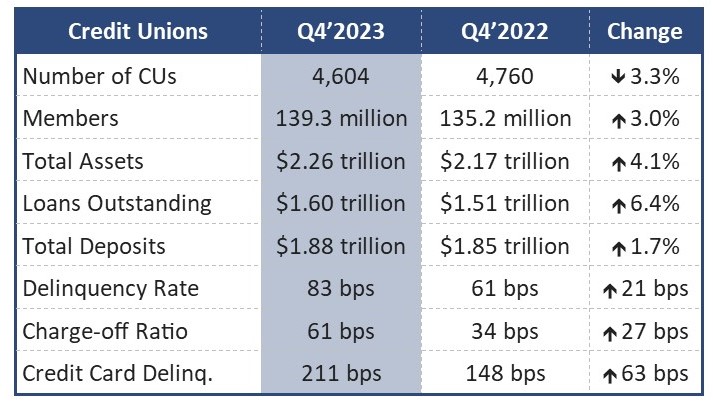Navy Federal Credit Union claims close to 10% of all members of federally-insured credit unions in the nation. It has roughly the same number of members as the 3,375 credit unions with less than $200 million in assets, combined (73% of the industry).
Membership at other large credit unions is growing as well. While no other federally-insured credit union comes anywhere close to Navy FCU's size, in this issue we look at different ways that some CUs are expanding their reach.
The industry as a whole added four million new members over the course of 2023. The 50 credit unions listed in this week's issue of Jumbo Rate News added more than three million of them and Navy Federal added a quarter of all of those new members all by itself.
Credit Union Membership Nears 140 million
Fourth quarter credit union data is now available and all star-ratings (banks and CUs) have been updated on our website: bauerfinancial.com.
We lost 156 credit unions during calendar 2023. That is pretty consistent with recent years as the industry continues to consolidate. The 4,604 remaining federally-insured CUs are exhibiting steady growth: 3% growth in membership; 4.1% in assets and 6.4% in loans.
Total share/deposit growth lagged behind at just 1.7%. That would seem to indicate that consumers are spending (and borrowing) more than they are saving. Backing that up, the average CU loan balance was up 4.5% over the year to $17,922.
Credit card balances by themselves grew 10.5% over the year with delinquent credit card balances rising to 2.11%. That’s 63 basis points higher than a year ago. At 83 basis points, the overall delinquency rate is still well under 1%, but if it continues to grow at the same pace, it will be above that mark by the end of this year.
The industry has taken note. Loan loss provisions increased more than 100% ($5.8 billion) and stood at $11.3 billion at year-end. Our primary focus today, however, is membership.
Jumbo Rate News will not be published next week. We will be back on April 8th with JRN issue 41:14.
Federally-insured credit unions added four million new members over the course of 2023, as total membership in the nation’s credit unions reached 139.3 million at year-end. The 50 listed on page 5 added more than three million of those new members by themselves. 5-Star Navy FCU, Vienna, VA, the largest U.S. credit union (by far) claimed more than one million (one quarter) of all new members.
In fact, Navy FCU claims: 9.6% of all federally-insured credit union members; 7.6% of industry assets; 7.9% of total loans; and 7.7% of all federally-insured C.U. deposits.
For comparison purposes, there are 3,375 federally-insured CUs with assets of less than $200 million each. (That’s 73% of the industry!) Combined, these CUs have roughly the same membership as Navy FCU.
The 73% group has even a smaller piece of the pie than Navy FCU in other categories: 7.1% of industry assets, 5.9% of total loans and 7.4% of all industry deposits.
Last June, 5-Star TwinStar CU, Olympia, WA added more than 100,000 new members by way of its acquisition of Northwest Community CU, Eugene, OR. What started as a modest teachers’ credit union back in 1938, TwinStar now boasts a membership exceeding a quarter of a million and has branches spanning Washington State as well as throughout several counties in Oregon.
5-Star Mountain America FCU, Sandy, UT also has roots dating back to the 1930s and also added over 100,000 new members in 2023. Unlike TwinStar, however, Mountain America FCU expanded its membership last year by opening two new branch offices, one in Colorado City, AZ and the other in Meridian, ID. Mountain America FCU now operates through over 100 branch offices in six states (AZ, ID, MT, NM, NV and UT).
With $29.2 billion in total assets, 5-Star SchoolsFirst FCU, Santa Ana, CA is the largest credit union in California. As its name suggests, SchoolsFirst FCU is open to the education community (and their families) in the Golden State, just as it has been since its inception in 1934. SchoolsFirst FCU added nearly 92,000 members in 2023. Its new members tend to come more from word of mouth referrals than from large expenditures (i.e. an acquisition or new branches).
While quite a bit smaller than SchoolsFirst, the 4-Star Suncoast CU, Tampa, FL is the largest credit union in the Sunshine State, with $17.4 billion in assets. Suncoast is a community credit union; anyone who lives, works, attends school or worships in the 30 plus Florida counties that Suncoast services is eligible to join. To reach its audience, Suncoast has taken advantage of the internet and YouTube -from “Spencer the Influencer” to “My Suncoast Success Stories”. Virtual engagement has proven to be great success as Suncoast attracted over 86,000 new members last year.
5-Star Alliant CU, Chicago, IL (Illinois’ largest CU) takes that a step further. It has no branches at all (JRN 41:08); everything is digital. Last year, Alliant made investments to improve that digital experience and enhance its mobile app. The investment paid off with nearly 79,000 new members joining.
As these credit unions can attest, there is not one right way to grow membership. However, just as we see in banks, the biggest credit unions keep getting bigger.


